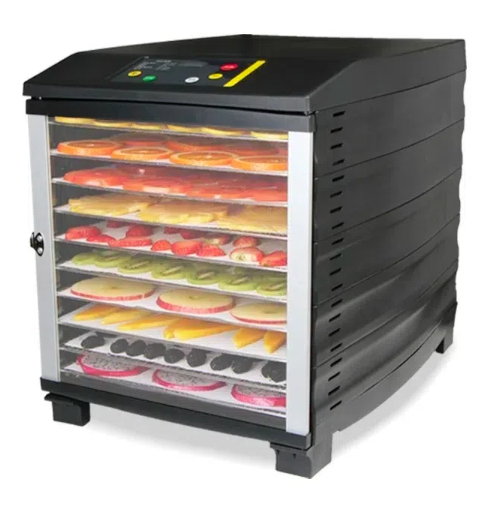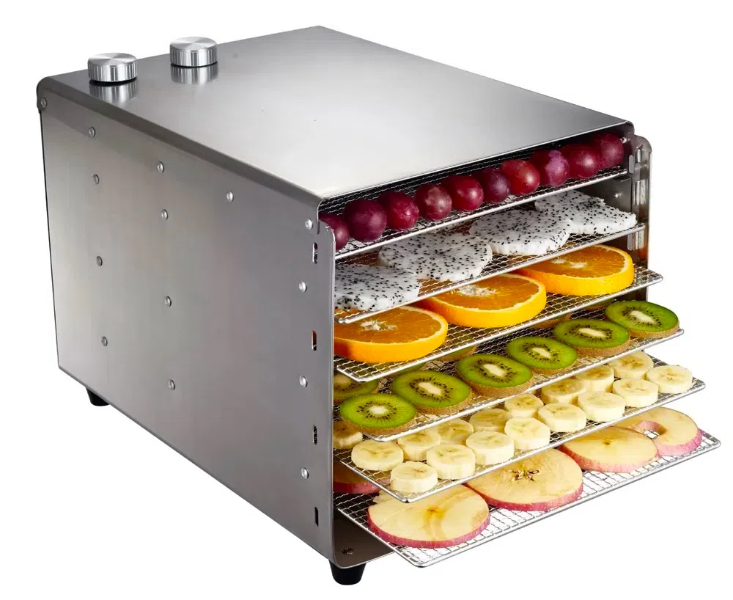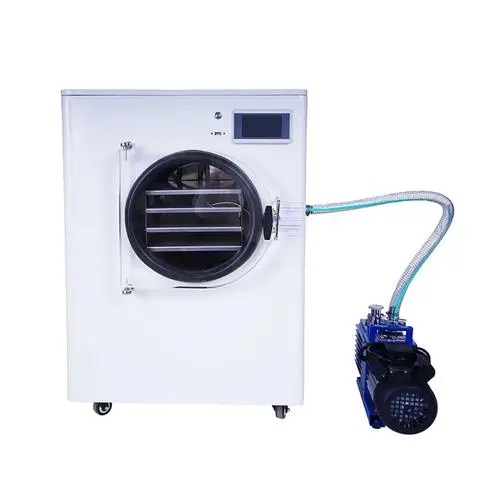
Content Menu
● Introduction to Food Dehydration
● What is a Fruit Dryer Machine?
● The Benefits of Using a Fruit Dehydrator
● How Does a Food Dehydrator Work?
● Types of Food Dehydrators
>> 1. Stackable Tray Dehydrators
>> 2. Shelf Tray Dehydrators
>> 3. Multi-Tier Fruit Dryers
● Key Features to Look for in a Fruit Dryer Machine
>> 1. Adjustable Temperature Control
>> 2. Even Air Flow
>> 3. Capacity
>> 4. Noise Level
>> 5. Timer
>> 6. BPA-Free Materials
● Popular Foods to Dehydrate
>> 1. Fruits
>> 2. Vegetables
>> 3. Herbs
>> 4. Meats
● Tips for Successful Food Dehydration
● The Versatility of a Stainless Steel Food Dehydrator
● Beyond Snacking: Creative Uses for Your Fruit Dryer Machine
● The Role of Food Dehydrators in Home Food Preservation
● Choosing the Right Fruit Dryer Machine for You
● Maintenance and Care of Your Food Dehydrator
● Conclusion: Embracing the World of Food Dehydration
● Frequently Asked Questions
>> 1. What is the best temperature for drying fruits in a dehydrator?
>> 2. How long does it take to dehydrate fruits?
>> 3. Can I dehydrate frozen fruits?
>> 4. How do I know when my fruits are fully dehydrated?
>> 5. How long can I store dehydrated fruits?
Introduction to Food Dehydration
In today's fast-paced world, where convenience often trumps nutrition, there's a growing trend towards healthier, more natural food options. Enter the fruit dryer machine, a revolutionary appliance that's changing the way we preserve and enjoy nature's bounty. Whether you're a health enthusiast, a busy parent, or simply someone who loves snacking on dried fruits, a food dehydrator can be a game-changer in your kitchen.
What is a Fruit Dryer Machine?
A fruit dryer machine, also known as a food dehydrator or electric food dryer, is a kitchen appliance designed to remove moisture from foods. This process not only extends the shelf life of fruits, vegetables, and meats but also concentrates their flavors and nutrients. The result? Delicious, nutritious snacks that can be enjoyed year-round.
The Benefits of Using a Fruit Dehydrator
1. Preserves Nutrients: Unlike other preservation methods, dehydration retains most of the food's original nutrients.
2. Extends Shelf Life: Dried foods can last for months or even years when stored properly.
3. Saves Money: Buy fruits and vegetables in bulk when they're in season and preserve them for later use.
4. Reduces Waste: Dehydrate fruits and vegetables that are about to spoil, reducing food waste.
5. Versatility: From fruits and vegetables to herbs and meats, you can dehydrate a wide variety of foods.
How Does a Food Dehydrator Work?
A typical food dehydrator consists of several key components:
1. Heating Element: Generates warm air to facilitate the drying process.
2. Fan: Circulates the warm air evenly throughout the unit.
3. Trays: Hold the food items being dehydrated.
4. Adjustable Thermostat: Allows you to control the drying temperature.
5. Timer: Helps you monitor the drying time.
The process is simple yet effective. The heating element warms the air, which is then circulated by the fan. This warm air passes over and through the food, gradually removing moisture. The adjustable temperature control ensures that different types of foods are dried at their optimal temperatures.

Types of Food Dehydrators
1. Stackable Tray Dehydrators
These are the most common and affordable options. They feature a vertical stack of trays, with the heating element and fan typically located at the base or top of the unit. Stackable dehydrators are great for beginners and those with limited counter space.
2. Shelf Tray Dehydrators
Also known as cabinet dehydrators, these units resemble mini-ovens. They often offer more consistent drying results and are ideal for those who dehydrate foods frequently or in large quantities.
3. Multi-Tier Fruit Dryers
These are larger units designed for serious food preservation enthusiasts. They can handle large quantities of food and often come with advanced features like dual fans and multiple temperature zones.
Key Features to Look for in a Fruit Dryer Machine
1. Adjustable Temperature Control
Different foods require different drying temperatures. Look for a dehydrator with a wide temperature range, typically between 95°F to 165°F (35°C to 74°C).
2. Even Air Flow
Consistent air circulation is crucial for uniform drying. Some models feature horizontal air flow, which can be more effective than vertical systems.
3. Capacity
Consider how much food you plan to dehydrate regularly. Stackable models allow you to add or remove trays as needed.
4. Noise Level
Some dehydrators can be noisy due to their fans. If this is a concern, look for models advertised as quiet or low-noise.
5. Timer
A built-in timer can be very convenient, allowing you to set the drying time and walk away without worrying about over-drying your food.
6. BPA-Free Materials
Ensure that the trays and other components that come into contact with food are made from BPA-free materials for food safety.

Popular Foods to Dehydrate
1. Fruits
Apples, bananas, berries, mangoes, and pineapples are all excellent choices for dehydration. Dried fruits make great snacks and can be added to cereals, yogurt, or baked goods.
2. Vegetables
Carrots, bell peppers, onions, and tomatoes dehydrate well. Use them in soups, stews, or as healthy chip alternatives.
3. Herbs
Preserve the flavors of your garden by drying herbs like basil, oregano, and thyme.
4. Meats
Make your own jerky using beef, turkey, or even fish. A jerky maker machine setting on your dehydrator can help achieve the perfect texture.
Tips for Successful Food Dehydration
1. Prepare foods uniformly: Cut fruits and vegetables into even-sized pieces for consistent drying.
2. Pre-treat fruits: Dip fruits prone to browning (like apples and bananas) in lemon juice or ascorbic acid solution before drying.
3. Use the right temperature: Follow recommended temperatures for different food types to ensure food safety and optimal results.
4. Rotate trays: If your dehydrator doesn't have horizontal air flow, rotate the trays periodically for even drying.
5. Store properly: Once dried, store foods in airtight containers in a cool, dark place.
The Versatility of a Stainless Steel Food Dehydrator
While plastic dehydrators are common, stainless steel food dehydrators offer several advantages:
1. Durability: Stainless steel is more resistant to wear and tear.
2. Easy to Clean: Stainless steel surfaces are typically easier to clean and maintain.
3. Even Heat Distribution: Metal conducts heat more efficiently, leading to more consistent drying results.
4. Longevity: A well-maintained stainless steel dehydrator can last for many years.
Beyond Snacking: Creative Uses for Your Fruit Dryer Machine
1. Make Fruit Leathers: Create healthy, homemade fruit roll-ups using pureed fruits.
2. Dry Flowers: Preserve flowers for crafts or potpourri.
3. Make Pet Treats: Create healthy, preservative-free treats for your furry friends.
4. Dry Bread Crumbs: Never waste stale bread again by turning it into dried breadcrumbs.
5. Create Spice Blends: Dry and grind your own unique spice mixtures.
The Role of Food Dehydrators in Home Food Preservation
Food dehydration is one of the oldest methods of food preservation, dating back thousands of years. Today, electric food dryers make this ancient practice accessible to everyone. As part of a comprehensive home food preservation strategy, a food dehydrator can complement other methods like canning and freezing.
Benefits of home food preservation include:
1. Reducing food waste
2. Saving money by buying in bulk and preserving
3. Controlling ingredients and avoiding additives
4. Preparing for emergencies
5. Enjoying seasonal foods year-round
Choosing the Right Fruit Dryer Machine for You
When selecting a fruit dryer machine, consider the following factors:
1. Frequency of Use: If you plan to dehydrate foods regularly, invest in a higher-quality, more durable model.
2. Available Space: Consider where you'll store and use the dehydrator. Stackable models are great for small kitchens.
3. Budget: Prices can range from budget-friendly to high-end. Determine what features are most important to you.
4. Types of Food: If you plan to make a lot of jerky, look for a model with a specific jerky maker machine setting.
5. Energy Efficiency: Look for models with good insulation and energy-saving features if you're concerned about electricity usage.
Maintenance and Care of Your Food Dehydrator
Proper maintenance of your fruit dryer machine will ensure its longevity and optimal performance:
1. Clean after each use: Wash trays and other removable parts with warm, soapy water.
2. Check the fan and heating element: Ensure they're free from food particles or debris.
3. Store properly: Keep your dehydrator in a clean, dry place when not in use.
4. Inspect regularly: Check for any signs of wear or damage, especially on the cord and heating element.
Conclusion: Embracing the World of Food Dehydration
A fruit dryer machine is more than just an appliance; it's a gateway to a healthier lifestyle, reduced food waste, and culinary creativity. Whether you're drying summer fruits for winter enjoyment, creating homemade trail mix for your next hike, or experimenting with new jerky flavors, a food dehydrator opens up a world of possibilities.
As we become more conscious of what we eat and how our food is prepared, tools like electric food dryers empower us to take control of our nutrition. By preserving foods at home, we can ensure that our snacks and ingredients are free from unnecessary additives and preservatives.
So, whether you're a seasoned food preservation enthusiast or a curious beginner, consider adding a fruit dehydrator to your kitchen arsenal. With its versatility, ease of use, and potential for creativity, it's an investment in your health, your wallet, and your culinary adventures.

Frequently Asked Questions
1. What is the best temperature for drying fruits in a dehydrator?
Answer: The optimal temperature for drying most fruits is between 135°F to 145°F (57°C to 63°C). However, it's essential to consult your dehydrator's manual, as recommendations may vary slightly between models.
2. How long does it take to dehydrate fruits?
Answer: The drying time for fruits can vary depending on the type of fruit, its water content, and the thickness of the slices. On average, it can take anywhere from 6 to 16 hours. For example, apple slices might take 7-15 hours, while banana chips could be ready in 6-10 hours.
3. Can I dehydrate frozen fruits?
Answer: Yes, you can dehydrate frozen fruits. In fact, some people prefer using frozen fruits as they're often picked at peak ripeness. Thaw the fruits first, pat them dry to remove excess moisture, and then proceed with dehydration as you would with fresh fruits.
4. How do I know when my fruits are fully dehydrated?
Answer: Properly dehydrated fruits should be leathery and pliable, without any pockets of moisture. They shouldn't stick together when you press them. If you're unsure, it's better to over-dry slightly than under-dry, as under-dried fruits can develop mold during storage.
5. How long can I store dehydrated fruits?
Answer: When stored properly in airtight containers in a cool, dark place, most dehydrated fruits can last 6-12 months. Some fruits, like raisins, can last even longer. Always check for any signs of moisture or mold before consuming stored dried fruits.












